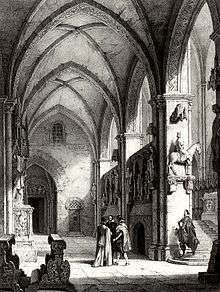Bamberg Horseman

The Bamberg Horseman (German: Der Bamberger Reiter) is a stone equestrian statue by an anonymous medieval sculptor in the cathedral of Bamberg, Germany.
Description
Dating probably from the time before the consecration of the cathedral's new building in 1237, but after 1225, it is located on a console at the north pillar of the St. George choir, it is not known whether this is the intended position of the statue although the base appears to be original and the structure of the base would seem to dissuade moving.[1]
Interpretation
Being located in a church and showing a crowned yet unarmed man, it is believed that it represents a specific king, perhaps one who was a saint. A candidate is Emperor Henry II (973-1024) who is buried in the cathedral along with Pope Clement II, but he would likely have been depicted with Imperial Regalia. Another possibility is his brother-in-law, king Stephen I of Hungary (975-1038) who stops his horse and looks towards the tomb of Henry. Another theory favours Emperor Frederick II, the Holy Roman Emperor at the time, who financed much of the rebuilding of the cathedral.[2] Yet another theory, supported by Hannes Möhring of the University of Bayreuth, holds that the figure represents the Messiah according to the Book of Revelation (19:11–16).
It is considered the first monumental equestrian statue since classical antiquity, and also one of the first to depict a horse shoe. Beneath the horse's front hooves is one of the many sculptural representations of the Green Man. Kathleen Basford, in her study of these figures, calls this Green Man the "dark counterpart" of the horseman.
Stefan George wrote a poem about the horseman.[3] His work influenced Claus Schenk Graf von Stauffenberg,[4] the would-be assassin of Hitler who was a member of the cavalry unit Bamberger Reiter- und Kavallerieregiment 17 (17th Cavalry Regiment).[5]
See also
References
- ↑ P. Williamson, Gothic Sculpture, 1140-1300, 1995: pp. 95
- ↑ W. R. Valentiner, The Bamberg Rider: Studies of Mediaeval German Sculpture, Zeitlin & Ver Brugge, 1956 online excerpts
- ↑ Baigent, Michael; Leigh, Richard (Dec 13, 2013). Secret Germany: Stauffenberg and the True Story of Operation Valkyrie. Skyhorse Publishing, Inc. ISBN 9781626369092.
- ↑ Herbert Ammon: Vom Geist Georges zur Tat Stauffenbergs - Manfred Riedels Rettung des Reiches, in: Iablis 2007 at www.iablis.de
- ↑ Jones, Nigel (2008). Countdown to Valkyrie: The July Plot to Assassinate Hitler. Casemate Publishers. p. 22. ISBN 9781848325081.
Further reading
- Basford, Kathleen. The Green Man, D.S. Brewer (2004) ISBN 0-85991-497-6.
- Dieckmann, Guido. Die Nacht des steinernen Reiters. 2005. Aufbau Taschenbuch Verlag, ISBN 3-7466-2119-4.
- Möhring, Hannes. König der Könige. Der Bamberger Reiter in neuer Interpretation. Königstein im Taunus, 2004. Langewiesche-Verlag, ISBN 3-7845-2141-X.
External links
Coordinates: 49°53′27″N 10°52′58″E / 49.89083°N 10.88278°E